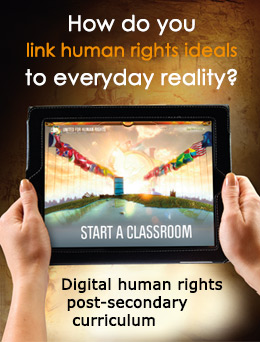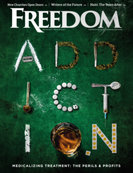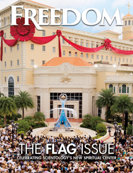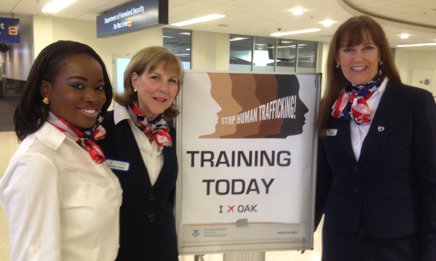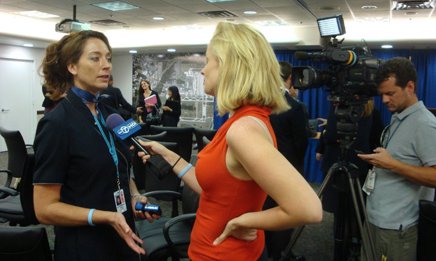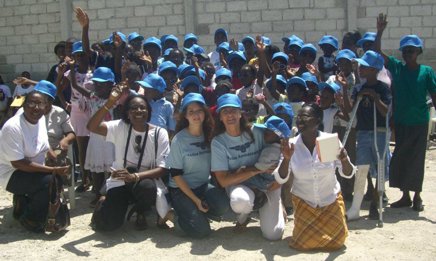A Higher Calling
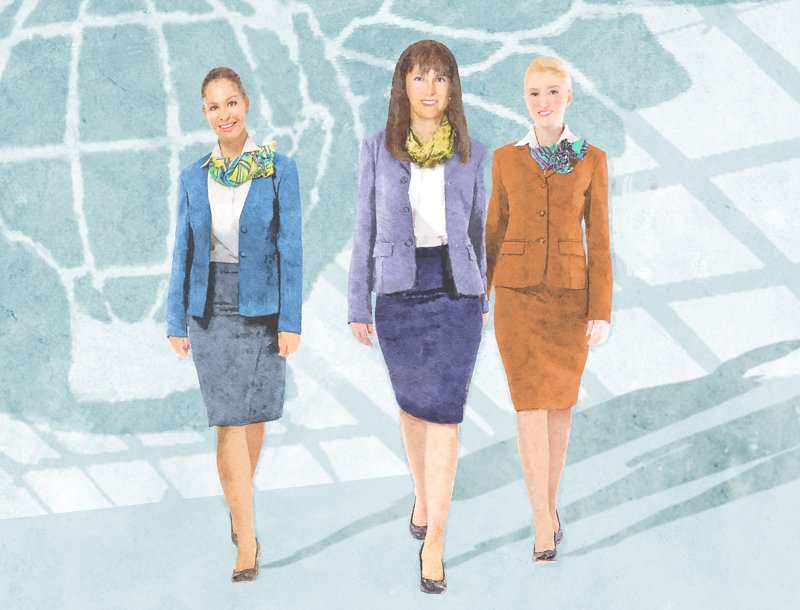
It was the early 1980s, and Nancy Rivard was in a funk.
Rivard worked as a flight attendant supervisor for American Airlines, but felt deeply unfulfilled. The sudden death of her father had sent her into a tailspin, and on a seven-year search for meaning in her life that would take her all over the world.
By the end, Rivard would give away all her possessions save a few bathing suits, move to Hawaii, and go back to being a flight attendant (rather than a manager). All the while she pondered: How can I make a difference?
“I ultimately realized that travel could be used as a means to awaken people and raise consciousness,” Rivard says. “My idea was to bring compassion into action.”
For all her international travels, Rivard knew a few things. One was just how little most kids in developing countries had, yet they were often content in a way that American children—even with so much, comparatively, in terms of possessions and comforts—were not. And she’d heard stories—awful stories—that spoke to the risk young people suffer at the whims of unscrupulous adults.
And so it was that in 1992, Rivard traveled to Rio de Janeiro for the United Nations Earth Summit. There she pitched everyone from prime ministers to airline executives to media moguls on her idea for a humanitarian program she planned to call Airline Ambassadors. She met with literally hundreds of people.
“No one was the least bit interested,” she recalls.
Yet Rivard kept at it. And kept getting doors slammed in her face, kept meeting with rejection from her superiors at the airline where she worked, kept running into brick walls.
“That’s when this inner voice said, ‘Nancy, quit talking about it and start doing it!’”
And so she did. Rivard moved forward on her own—slowly at first, then gaining momentum and a league of committed volunteers. In 1996, Airline Ambassadors International (AAI) was established as a nonprofit organization. Today, the group is affiliated with the United Nations and recognized by the U.S. Congress.
What began as a grassroots network of airline employees using their travel-pass privileges to help others has grown to include thousands of students, medical professionals, families, retirees and airline workers volunteering as Airline Ambassadors of goodwill. AAI programs bring humanitarian aid to orphans and vulnerable children around the world; provide medical escorts for kids traveling to the United States for medical treatment, and train airline and airport workers to recognize and report human trafficking. In 2014 alone, AAI volunteers leveraged contacts with the airline industry to contribute more than 89,000 combined hours of service and spent a half million dollars of their own money to carry out the work.
Under its humanitarian aid program, the charity has established medical clinics, food programs, schools, vocational training centers, housing projects and sustainable agriculture throughout the developing world. AAI volunteers have hand-delivered $60 million in aid to needy children and families in 59 countries.
Cheryl Robinson is regional director for AAI Detroit and a humanitarian mission leader. She made a trip to the Philippines in April 2014 to bring aid to an orphanage near Manila, in the form of medicine and school supplies. Robinson, a Delta Airlines flight attendant, also took the home’s 86 fulltime residents on a visit to a nearby aquarium.
Volunteers hope to build a playground at the orphanage on their next trip. “We’ve also raised money to bring bicycles for all of the kids,” Robinson says.
Robinson and AAI volunteers visited 75 families living at a Manila dump site without running water. “You can’t even believe the conditions these people are forced to endure,” she says. “When we got there, many of them apologized for smelling bad because they had no water to use for bathing and showering. These people had no water for cooking, brushing their teeth, washing their clothes.”
AAI volunteers paid for a permanent water hookup for those at the dumpsite, “to make their lives at least somewhat more livable,” says Robinson.
Another Airline Ambassadors program provides medical escorts to children with health issues. To date, AAI volunteers are credited with escorting more than 1,500 babies and children from countries including Nepal, Burkina Faso, Uzbekistan, China, Indonesia, Guyana, Ivory Coast, Liberia, Cameroon, Afghanistan, Honduras and Peru.
The children—identified by other nonprofit groups—are brought to the United States for surgery and treatment addressing serious conditions like congenital heart problems, cleft palate, scoliosis, severe burns and debilitating orthopedic issues. The founding agencies (like Healing the Children) save significant monies by utilizing flight attendants’ travel benefits to transport the young patients. For example:
“American Airlines has been invaluable to our program since it gives active employees high priority bookable passes when they go on escort trips,” says Margaret Whitehead, director of the AAI medical escort program, which counts 250 current and retired airline employees among its volunteers, 85 percent of whom are affiliated with American.
The support AAI volunteers provide is more than financial and logistic, adds Whitehead. The escorts also supply comfort to children fearful at the prospect of medical treatment and dealing with the anxiety of traveling far from home and away from their families. “These trips are anything but easy,” Whitehead says. “You’re taking a child from the only family they’ve ever known and you likely don’t speak the same language as they do. They leave literally kicking and screaming.”
Difficult as it is, the escorts feel honored to be a part of something so important, says Bunny Doi, a flight attendant based in Chicago. Doi has personally escorted more than 100 children for Airline Ambassadors. “We travel with these children and serve as a bridge with the foster families who care for them both before and after their surgeries,” she says. “It’s a huge responsibility to reassure terrified mothers that their child will be well taken care of, but it’s my privilege to be a part of something that helps children in need as they embark on a life-changing experience.”
Quite on the flipside, in February 2015 AAI conducted its 27th Child Trafficking Awareness Training at Chicago’s O’Hare Airport, part of a global initiative to raise human-trafficking awareness—the third prong of AAI’s work. The Department of Justice estimates that between 17,000 and 25,000 children are trafficked each year through O’Hare, one of the largest U.S. airline hubs.
The program trains gate agents, security and other airport personnel in how to spot trafficking of babies, children, teens and young adults, both at the airport and onboard flights, and how to safely intervene. The initiative is particularly close to the heart of AAI volunteer Sandy Fiorini Hodges.
Hodges logged a 42-year career as a flight attendant before retiring in 2014. She spent much of that time frustrated by a system that seemed unwittingly designed to protect smugglers trading in the sexual enslavement of young boys, girls and women, and infants trafficked for adoption or harvested for organs.
“I would see the signs onboard my flights all the time and didn’t know what to do,” says Hodges, a founding member of Airline Ambassadors. “I’d jump off the plane, call police and be told they were sorry but there was nothing they could do. It was just heartbreaking. I saw it all the time. But this was in the 1970s and ’80s, before anyone even knew what human trafficking was.”
Hodges didn’t have much more success when she raised the issue to her superiors, who didn’t think it good for business to put out the image of flight attendants policing and profiling its flight customers. “It was unbelievably frustrating,” she remembers.
In 1996, Hodges met Rivard and Airline Ambassadors was born—with human trafficking among the issues they were determined to address. It would be a dozen years before the timing was right to tackle it, but in 2008 AAI partnered with Deborah Sigmund of Innocents at Risk, a nonprofit founded to fight child exploitation and human trafficking. The partnership led to the implementation of an initiative enabling flight personnel to raise the alarm from the air and have officials confront suspected human traffickers on landing. Under that initiative, in 2009 AAI personnel correctly identified trafficking incidents on two different airlines originating in the Dominican Republic, leading to the cracking of a human trafficking ring involving 82 children.
“I feel like we’ve only taken a tiny nibble out of a huge problem,” Hodges stresses. “The thing is, when you see a situation that you know is trafficking and you choose to do nothing, you are complicit in what happens to that person as a result. You can’t look the other way.”
Alicia Kozakiewicz couldn’t agree more. The 27-year-old is earning her master’s degree in forensic psychology and recently became an Airline Ambassadors human trafficking awareness trainer. She’s also a survivor of human trafficking herself.
In 2002, when she was 13, Kozakiewicz was abducted outside her Pittsburgh home by a 38-year-old man she met in an Internet chat room. She was held hostage, chained to the floor in the man’s home, tortured and sexually assaulted for four days. A tip to the FBI—from someone who didn’t look the other way—led to Kozakiewicz rescue and to the perpetrator’s arrest and conviction.
“The discomfort you may be feeling in interrupting your trip to Disney World is nothing compared to the hell a child may be going through,” she says.
AAI conducted its first training of flight crews in Europe in 2013 and in the past two years has made presentations at the annual Interpol Global Trafficking in Human Beings Conference.
A forthcoming AAI-developed mobile phone app will permit a growing Airline Ambassadors Hero Force—made up of onboard air personnel and the flying public—to report suspected cases of trafficking on the fly. And Chicago’s O’Hare is the first U.S. airport with plans to widely display AAI human-trafficking awareness materials to the flying public.
“I know the fear is that flight attendants and others will become vigilantes,” says AAI president Rivard. “But at the same time, our message is never to intervene yourself. It’s all about discreetly recognizing and reporting.”
Rivard retired from her flight-attendant career in August 2013 and now dedicates all of her time to the volunteer group she founded.
She sees herself more as a conduit than a hero, driving—among other things—awareness of the tragedy of human trafficking, which is the world’s fastest-growing criminal industry, according to the U.S. Department of State.
“This effort is slowly taking hold as the travel industry comes to realize that we all must work together in the protection of the public good,” Rivard says. “As people become enlightened, they can’t help but feel galvanized by an issue that’s so fundamental to our common humanity. There’s much more to be done. But we have a foot in the door, and now that we’ve awakened people, anything is possible.”







